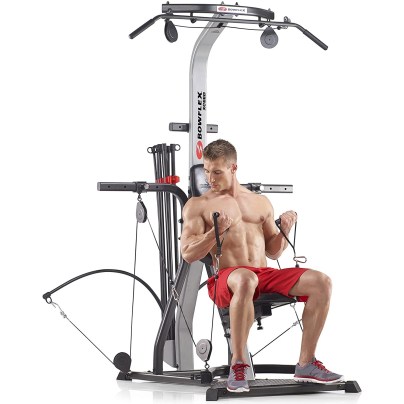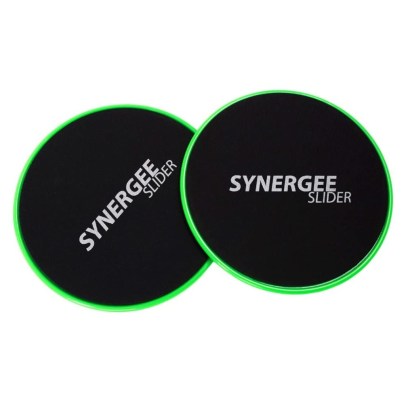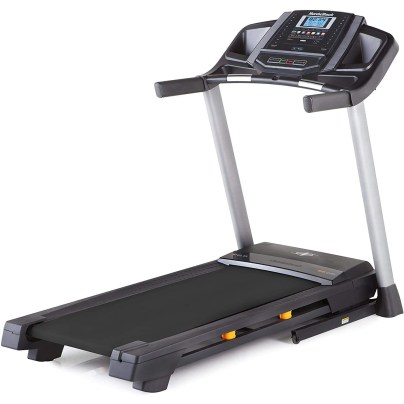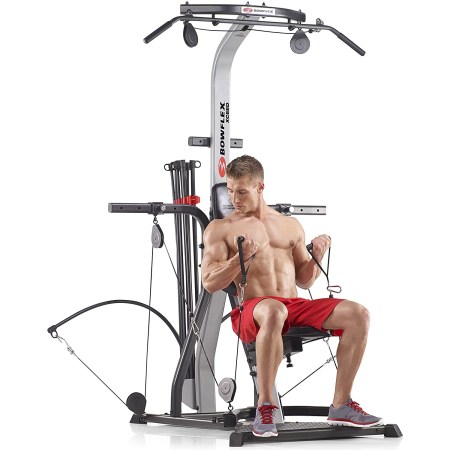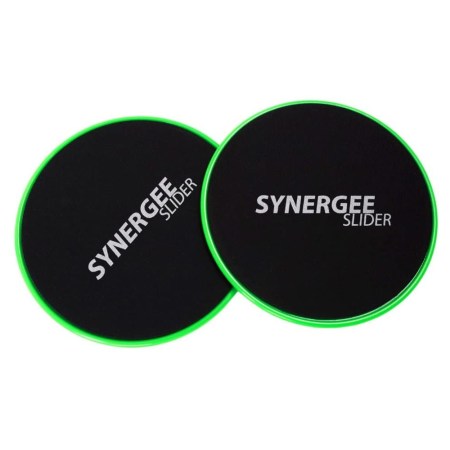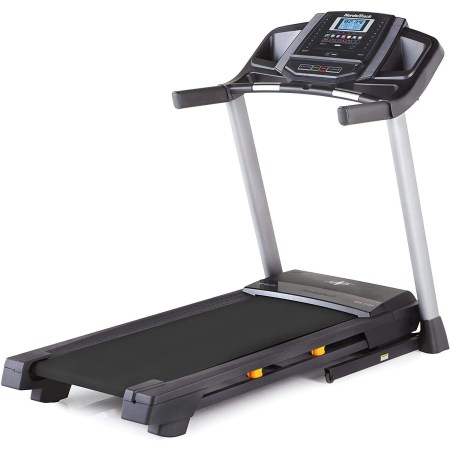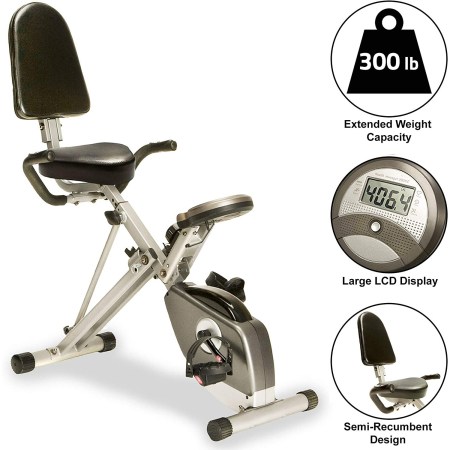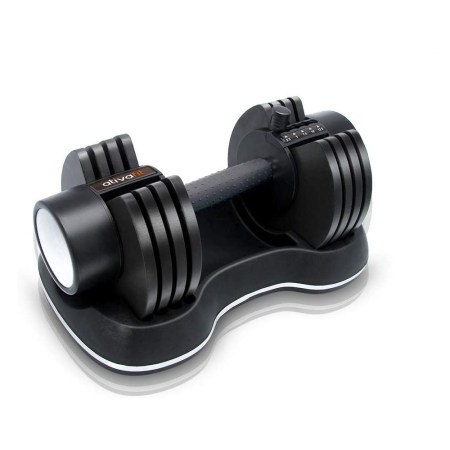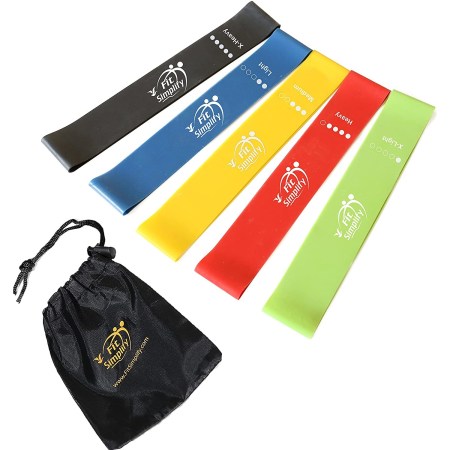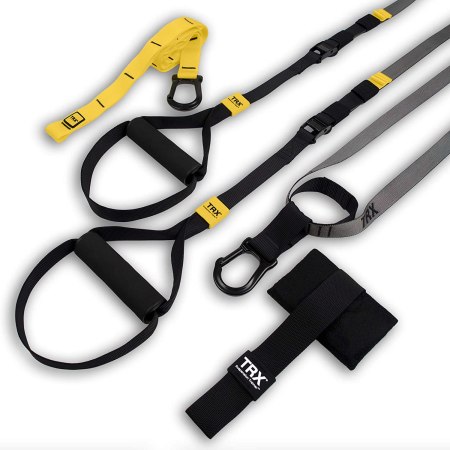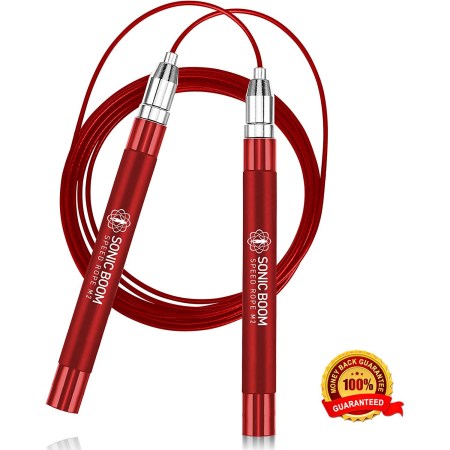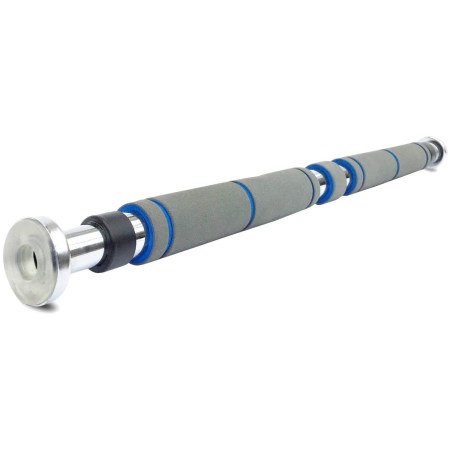We may earn revenue from the products available on this page and participate in affiliate programs. Learn More ›
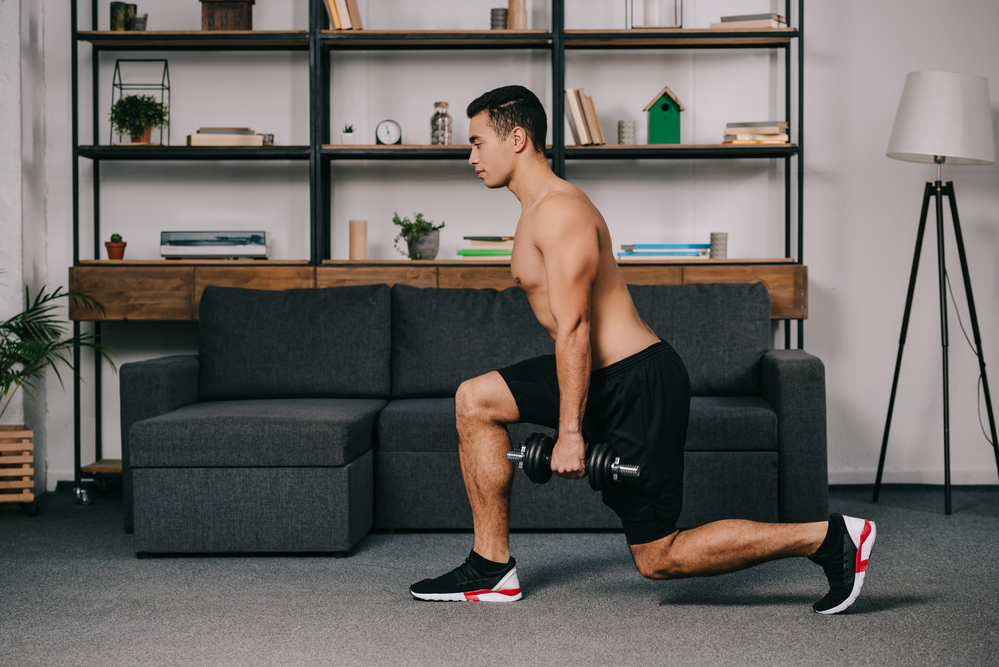
To avoid paying a monthly membership fee, consider creating a workout space in your home. With little cost after the initial investment in your home workout equipment, you’ll be able to eliminate that monthly expenditure from your list of bills.
Working out from home can save you not only money but time, too. The convenience of waking up and walking downstairs to exercise is a major perk. The only drawback is you won’t be able to find an excuse to skip a workout once you outfit your home gym.
Keep reading to learn about what to consider when selecting some of the best home gym equipment, how to set it up properly, and to learn more about our top recommendations:
- BEST OVERALL: Bowflex Xceed Home Gym
- BEST BUDGET: Synergee Dual Sided Use Core Sliders
- BEST TREADMILL: NordicTrack T Series Treadmill (6.5S)
- BEST STATIONARY BIKE: Exerpeutic Folding Recumbent Bike
- BEST DUMBELLS: ATIVAFIT Adjustable Dumbbell
- BEST RESISTANCE BANDS: Fit Simplify Resistance Loop Exercise Bands
- BEST TRAINING STRAPS: TRX GO Suspension Training
- BEST JUMP ROPE: Sonic Boom M2 High Speed Jump Rope
- BEST PULL UP BAR: Garren Fitness Maximiza Pull Up Bar
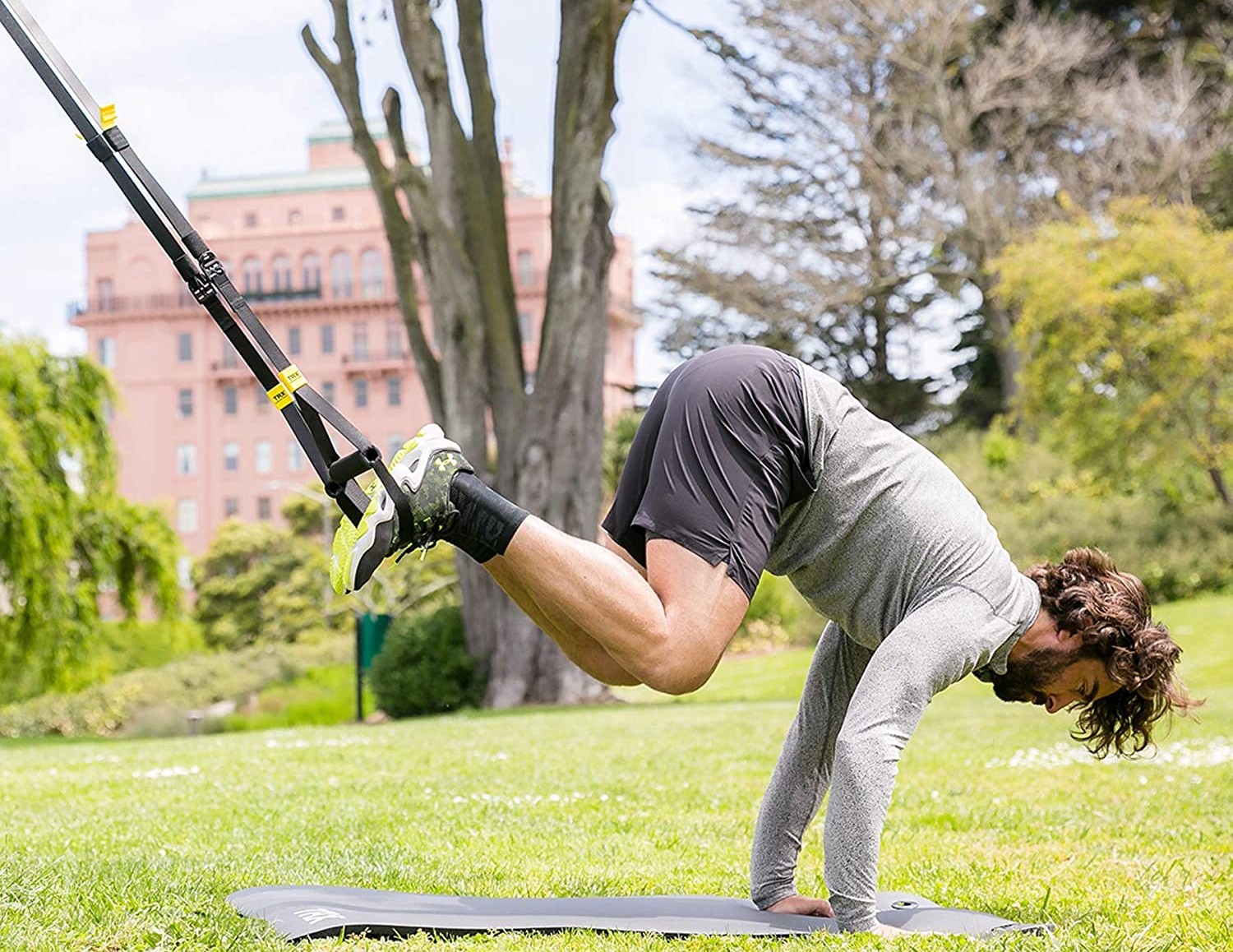
What to Consider When Choosing the Best Home Gym Equipment
One way to create a home gym is to start small and build it out over time. Fitness enthusiasts can still get a great workout with very little equipment. If you’re not ready to invest in a multi-use or cardio machine, consider streaming online exercises and using free weights, training straps, or resistance bands. From big to small and splurges to steals, you’ll want to keep in mind the following factors when shopping for and using the best home gym equipment:
Type
Home gym equipment spans a wide range of products, from simple free weights to robust full-body fitness machines. It’s advantageous to have a few types of equipment for a good workout as well as to mix up your fitness routine. Common types of home gym equipment include:
- Treadmill: Made for walking, jogging, and running indoors, a treadmill is a home gym staple for cardio workouts.
- Elliptical: Ellipticals are an excellent low-impact cardio machine that is easier on your joints than running on the treadmill while offering a full-body workout.
- Stationary bike: Strengthen your legs with a stationary bike, which will provide low-impact cardio and engage your glutes, quads, hamstrings, and calves.
-
Stair climber: A stair climber mimics climbing a flight (or endless flights) of stairs to improve cardio, core, and lower-body fitness.
Rowing machine: It might not look like it at first, but a rowing machine provides a full-body workout and is suitable for all fitness levels. - Dumbbells: Dumbbells are a versatile must-have in most home gyms. These free weights can be used for a range of exercises, from bicep curls to weighted lunges.
- Barbells: With a middle bar and a weight on each end, barbells are a popular piece of equipment for compound lift exercises that require a higher weight than dumbbells.
- Kettlebells: Their large spherical weight and top handle make kettlebells an excellent weight type for functional movements that involve swinging or explosive movements.
- Exercise or yoga mat: Some type of exercise mat is an essential piece of home workout gear, giving you a soft and secure nonslip surface for stretching, yoga, weight lifting, and more. Exercise mats tend to be thicker, while yoga mats tend to be thinner and feature a nonslip surface for holding yoga poses.
Available Space
The best home gyms aren’t necessarily packed with equipment—instead, they make great use of the available space. Get creative when thinking about where it might fit; consider giving a second life to an unused garage or an unfinished basement. If your only space is the corner of your bedroom, you still have options—you may just have to get a little more inventive.
There are equipment choices for mostly every size space, but plan accordingly. According to the American Council on Exercise, a multistation gym needs 50 to 200 square feet, treadmills necessitate about 30 square feet, and free weights require 20 to 50 square feet of space for proper use.
In a more compact area, focus on smaller equipment like weights and bands, and choose machines that will fold up or tuck away easily. You might also consider spending a bit more on one of the best full-body workout machine options to maximize your use of the small space. For larger spaces, consider multiuse or cardio machines that will offer a real gym experience. See below for more on how to properly set up your home gym.
Safety
When shopping for home fitness equipment, take note of each item’s safety features. For instance, treadmills will usually include an emergency shut-off key that you can clip to your clothing. This way, if you should fall, it automatically turns off the machine.
For weights and other handheld equipment, a textured safety grip will help prevent slipping. With doorway equipment, the mounting hardware should be heavy-duty and able to hold plenty of weight. When anchoring straps, look for ones that lock when looped to prevent them from slipping off, and make sure those bands and straps are sturdy enough to avoid snapping or tearing.
Intense routines will make you sweat, so it’s important to have proper ventilation, ideally with air conditioning. A ceiling fan can help with air circulation.
Accessories
If you want to set up an all-in-one home gym that replicates the fitness club experience, you have an endless choice of workout accessories available. Consider your needs and desires when shopping for smaller items. Here, think again about your local gym, where you may find towels to wipe sweat as your workout heats up, a good water bottle to help you stay hydrated, and mats to offer padding for stretching and other floor activities.
As you consider what to buy beyond the basic home gym essentials, keep in mind accessories that will amp up your workout. These include resistance bands, stability balls, medicine balls, kettlebells, jump ropes, and foam rollers. These items are also worth considering if you have limited space, as they can easily be stored away.
And don’t forget your technology, like music players and other items for entertainment while working out, as well as pedometers and heart rate monitors to track your stats.
Our Top Picks
Whether you’re shopping for larger exercise machines or just the essential workout equipment for home use, this guide showcases some of the best home exercise equipment for most budgets and setups.
Best Overall
Bowflex Xceed Home Gym
See ItUnique to Bowflex, the company’s Power Rod system features a resistance of up to 210 pounds, with the option to upgrade to 310 or 410 pounds. Top and chest-level pulleys and a lat bar provide tools for an upper-body workout. A seated leg press featuring detachable upholstered roller cushions and a squat bar accommodate leg and lower-body exercises. The quick-release seat is adjustable with a thick polyurethane high-density foam cushion, and the handles feature rubberized grips for comfort and safety.
Overall, the Bowflex is the ideal home gym machine for a versatile, powerful workout that suits almost any space. With a fairly compact footprint, the Xceed measures 53 inches long by 49 inches wide and 82 inches high. Though this home gym is an investment, it still comes in at a lower price than many competitors.
Product Specs
- Best for: Strength training
- Weight Range: 5 to 210 pounds
- Dimensions: 53 by 49 by 82 inches
Pros
- Accommodates over 65 exercises
- Suitable for a full-body strength-training workout
- Wide weight resistance range of 5 to 210 pounds (upgradeable to up to 410 pounds)
Cons
- May require several adjustments when switching between exercises
Get the Boxflex Xceed home gym equipment on Amazon.
Best Budget
Synergee Dual Sided Use Core Sliders
See ItLooking for some at-home gym equipment that doesn’t break the bank (or your back)? Sliders are a compact gym accessory used to amp up exercises like lunges, planks, and bridges by adding balance and stability challenges that force you to engage your core muscles. Each disk is 7 inches in diameter and is accompanied by a manual featuring five different exercises to try with them.
The sliders include two sides for different surfaces—a foam side for hard, smooth surfaces like hardwood floors and a plastic side for softer surfaces, like carpet or turf. For safety, start slow as you get used to the feel of your sliders underfoot.
Product Specs
- Best for: Strength training
- Weight Range: Body weight
- Dimensions: 7 by 7 by 0.5 inches each
Pros
- Safe for hard and soft flooring
- Affordable
- Easy to store
Cons
- Slippery surface means new users need to be careful to avoid injury
Get the Synergee core sliders on Amazon and at Walmart.
Best Treadmill
NordicTrack T Series Treadmill
See ItThe treadmill is a staple in any lineup of the best gym equipment for home gyms. Well suited for those looking for a cardio challenge, this NordicTrack treadmill comes with a 1-month trial period with the iFit app, which includes thousands of at-home workouts that can be streamed to your device and synced with your machine. If you choose the app’s personal coaching option, a trainer can control your treadmill to match the duration, speed, and incline of your workout. A safety key allows for a quick shutoff in case of a fall or other emergency.
One-touch controls eliminate scrolling by, allowing you to tap a number for easy adjustment of speed and incline. If space is of concern, an easy lift assist allows you to fold the base upright when not in use. When lifted, the machine measures 38 inches long by 36 inches wide and 54 inches high.
Product Specs
- Best for: Cardio
- Control Range: 0 to 10 percent incline control, 0 to 10 miles per hour speed control
- Dimensions: 73 by 35.8 by 67.5 inches
Pros
- Space-saving fold-up design for storage
- 1-touch controls
- Includes 30-day iFIT membership
Cons
- Unclear process to bypass iFIT subscription prompts for those who prefer to opt out
Get the NordicTrack T Series treadmill on Amazon and at Walmart.
Best Stationary Bike
Exerpeutic Folding Recumbent Bike
See ItFeaturing a semi-recumbent (or slightly reclined) design, this option includes comfort and safety features such as a large seat cushion and backrest and an easy mount and dismount experience. A precision-balanced flywheel—the weighted metal disk in place of a wheel—also facilitates a smooth and safe ride. If you’re focused on improving heart health, hand-pulse sensors on the handlebars can help target your heart rate zone.
Find your desired difficulty with an eight-level magnetic tension control system and track distance ridden, calories burned, time, speed, and pulse on an LCD (liquid crystal display). The Exerpeutic 400 XL has a 300-pound weight capacity.
Product Specs
- Best for: Cardio
- Control Range: 8 levels
- Dimensions: 20 by 17 by 54 inches
Pros
- Comfortable and beginner-friendly
- Affordable
- Foldable design
Cons
- Not great for those over 6 feet tall
Get the Exerpeutic recumbent bike on Amazon and at Walmart.
Best Dumbbells
ATIVAFIT Adjustable Dumbbell
See ItInstead of a set of dumbbells, this option allows the user to change weights by using a push and slide mechanism. For safety, the company warns not to adjust the dumbbell weight unless it is securely housed in the tray provided. For comfort, while lifting, the handle is contoured with a soft textured grip.
If you like to work out with a weight in each hand, order two of these. This adjustable dumbbell sells at a higher price point than others, but its compact design will save plenty of storage space when compared to other weight sets.
Product Specs
- Best for: Strength training
- Weight Range: 5.5 to 27.5 pounds
- Dimensions: 13.39 by 7.87 by 5.91 inches each
Pros
- Adjustable weight
- Straightforward weight plate changing process
- Comfortable handle
Cons
- Pricier than basic dumbbells
Get the ATIVAFIT adjustable dumbells on Amazon.
Best Resistance Bands
Fit Simplify Resistance Loop Exercise Bands
See ItResistance bands are a home gym favorite; they’re compact, versatile, and budget-friendly. These five bands from Fit Simplify are ideal for complete beginners up to expert workout enthusiasts. The set includes a storage bag and an instruction guide for even more bang for your buck.
Made of natural tear-resistant latex, the five resistance bands have increasing resistance levels and can offer a full-body workout at an affordable cost. Each measures 12 inches by 2 inches for comfortable use. Since each band is a loop, it eliminates the need to knot the resistance band. Resistance levels range from extra-light to extra-heavy, so you can use the bands for a range of activities, including light stretching, physiotherapy exercises, or to boost a high-intensity workout.
Product Specs
- Best for: Strength training, flexibility
- Weight Range: 5 resistance levels
- Dimensions: 12 by 2 inches each
Pros
- Tear-resistant latex material
- Affordable
- Versatile and easy to store (storage bag included)
Cons
- Not suitable for those with latex allergies
Get the Fit Simplify resistance bands on Amazon and at Walmart.
Best Training Straps
TRX GO Suspension Training
See ItUnlike resistance bands, which target specific areas, suspension training will help you exercise large muscle groups. These bands can be anchored to a door, a rafter, a beam, a tree, a pole, or a post at a single anchor point with one of the two anchoring solutions (included). A locking loop provides an added safety feature to prevent slipping after you secure the strap around your anchor point.
Integrated handles and foot cradles aim at providing a comfortable workout for both standing and floor-based exercises. For those new to suspension training, the set includes a 35-page workout guide, a poster with posture suggestions, and 6 months free to the TRX app that offers over 1,000 workouts. Because it weighs only 1 pound, you can take it with you or easily store it away after your exercises.
Product Specs
- Best for: Strength training
- Weight Range: Body weight
- Dimensions: 50 by 1.97 by 0.1 inches (adjustable length)
Pros
- Very lightweight and portable
- Locking loop prevents slipping
- Comfortable handles and foot cradles
Cons
- To increase portability, straps have a thinner design than other TRX products
Get the TRX GO home gym equipment on Amazon.
Best Jump Rope
Sonic Boom M2 High Speed Jump Rope
See ItAnother option for small spaces, this jump rope can be used for a great warm-up or a full workout. The ball-bearing system offers a 360-degree rotation, while the polymer-coated cables provide speed and durability. The price is higher than some, but this version includes features made for fitness enthusiasts (not the neighborhood kids).
A patent-pending, self-locking, screw-free design allows you to adjust the cable’s length to suit your needs, with any excess stored inside the handles. No-slip silicone grips aim at providing comfort and slip-free safety.
Product Specs
- Best for: Cardio
- Weight Range: Body weight
- Dimensions: 10-foot length
Pros
- Affordable
- Adjustable length
- Screw-free design
- Ball-bearing system for smooth 360-degree rotation
Cons
- Prone to kinking
Get the Sonic Boom jump rope on Amazon and at Walmart.
Best Pull Up Bar
Garren Fitness Maximiza Pull Up Bar
See ItFor an upper-body workout without weights, this pull-up bar is an affordable, compact alternative. The bar has nonslip extra-long foam grips that are aimed at comfort while carrying out exercises.
The bar can be installed with the included hardware, which consists of three sets of screw-in door mounts that can be used at different places or heights. The adjustable bar can fit stable wood doorways from 26 to 39 inches wide. Always secure your bar to the door frame with the provided bracket set and screws for a safe installation. After mounting, make sure to pull on it to ensure it’s fully tightened before doing your exercises.
Product Specs
- Best for: Strength training
- Weight Range: Body weight
- Dimensions: Adjustable from 26 to 39 inches long
Pros
- Adjustable to fit 26- to 39-inch-wide doorways
- Nonslip and comfortable foam grip
- Includes mounting hardware
Cons
- Mounting process will leave holes in the door frame
Get the Garren Fitness pull up bar on Amazon.
Tips for Setting Up and Using Your Home Gym Equipment
Whether you have a basement to fill or a bedroom corner, you’ll want to set up your gym to maximize space and safety. Proper storage, such as bins and boxes, will help keep smaller items like straps and bands out of the way and avoid tripping hazards. Other safety considerations include ample lighting, the right cleaning supplies, and proper spacing between equipment (as outlined above).
Choose a sturdy spot to hang straps and bands if you plan to use those in your workout. Other considerations are proper flooring that can hold up to heavy equipment or sweat and a place for entertainment items such as televisions, tablets, and music players.
For safety purposes, make sure to talk to a health care professional before starting a new exercise routine, especially if you have pre-existing health conditions. It’s also important to take precautions at home, as you would at the gym, such as wearing the proper shoes and avoiding loose clothing that could become stuck in equipment.
Don’t forget to clean up your space after a workout by wiping down equipment to prevent bacteria growth, and put away loose gear to avoid tripping hazards. Also, keep kids away from heavy weights and machinery, especially when unsupervised.
For at-home strength training and to challenge yourself with heavy weights, it’s crucial to have a spotter to support you if you tire out. Start slowly as you get to know your equipment to avoid strains and injuries.
- Clear clutter from your workout space.
- Use storage solutions for loose gear and other accessories.
- Make sure you space your equipment out correctly.
- Ensure proper ventilation and temperature control.
- Have disinfectant wipes on hand.
- Consider mats or foam tiles to protect the floors.
- Create a media station for your tech items.
- Use a spotter or skip the super-heavy weights.
- Talk to your doctor about your exercise routine before beginning.
Our Verdict
With over 65 resistance-based exercise possibilities, the Bowflex Xceed Home Gym offers a full-body strength-training workout in one machine. For those with a lower budget and much less space, consider a pair of core sliders like the Synergee Dual Sided Use Core Sliders to add resistance to body-weight exercises.
How We Chose the Best Home Gym Equipment
To prevent injury and make working out a pleasure (as much as it can be), at-home workout equipment should be safe and user-friendly. When narrowing down the best home gym machine and equipment, we considered a few different criteria points, including quality, versatility, and affordability.
By researching each product and considering online reviews, we only included well-made products so you can stay safe and trust the equipment to hold up to your daily or weekly workout. When considering versatility, we prioritized gym equipment with multiple uses: One-trick ponies simply aren’t worth the investment for most people.
Setting up a home gym can be a pricey endeavor, so we included plenty of affordable options on our list as well as higher-end gym machines for those who want to bring their favorite gym equipment home. When applicable, we prioritized equipment that is easy to store since you’ll want to keep your home gym neat, especially if it’s in your living room or bedroom.
FAQs
If you’re wondering if home workouts will live up to your hopes or how to keep your equipment safe and clean, read on to find out the answers.
Q: Are home workouts effective?
Home workouts can be just as effective as exercising at the gym, as long as you have the right equipment and a commitment to using it.
Q: Which gym equipment is best for home use?
The best gym equipment for your needs is dependent on your workout routine and your available space. Small pieces of equipment like free weights, resistance bands, core sliders, jump ropes, and exercise mats are the best options for home gyms of all sizes. If you have a bit more space (and a higher budget), consider adding a gym machine like a treadmill or stationary bike.
Q: What should a beginner home gym have?
A beginner home gym can start with an exercise mat, resistance bands, and some type of free weight (like dumbbells or a kettlebell). These small and affordable pieces of equipment can be used for a wide range of at-home workouts to start your fitness journey.
Q: How can you keep home gym equipment clean?
Make sure to unplug machines before cleaning, then wipe down each item’s entire surface with disinfectant wipes.
